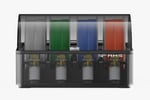The Automatic Material System, also known as AMS, by 3D printer company Bambu Lab, is a revolutionary automation system that allows users to print with 4 different colors and a variety of materials (potentially up to 16, but more on that later) in a single print.
This system is different from a normal multiple-spool holder because, aside from actually holding filament rolls, it also controls what filament is being used at which moment, meaning that it can switch as many times as needed during a single print – even in the same layer. While this may remind you of an accessory like the Mosaic Palette, it’s also more than that.
Read on to learn more about the AMS, how it works, how you can upgrade it, its pros and cons, and alternatives you might want to consider if you don’t have a Bambu Lab printer!
How Does It Work?

The AMS unit sits on top of the printer on two side rails and consists of three main parts.
The first and most obvious part refers to the four spool holders where filaments sit on individual rollers, reducing the force the printer needs to pull the material.
Next, the filament travels off the spool holder and is fed through its corresponding hub, where the material gets pulled from and fed to the last part, the buffer zone.
The buffer zone ensures that there are no gaps in between material changes and that the transitions between colors are as smooth as possible before the filament finally heads to the printer’s hot end. Along its path, the filament is constantly monitored by 10 different sensors to ensure that the loading and unloading of the various filaments are running as intended.
The order and transition of the filament feeding are predetermined in the Bambu Studio slicer. The software identifies different colors in a 3D file and calculates how much material of each filament will be needed per layer to achieve the final coloring result. The code is then read by the machine and the AMS feeds the needed filaments accordingly to create a multicolored 3D print. The AMS also accounts for automatic retraction to get the previous material out of the way, ensuring an even more seamless printing experience.
Compatibility

Printer compatibility for the AMS is currently quite limited, only being suitable for Bambu Lab options, specifically the P1 and X1 series. It could be possible to change the source code of the AMS to work with other printers, but that requires serious coding knowledge and would lead to voiding the AMS warranty.
Another limiting factor of the AMS is its material compatibility due to the integrated spool holder system. From a material standpoint, the AMS can handle any material that is stiff enough to withstand the travel to the hot end. This means that anything overly flexible like TPU or TPE won’t work, and anything too brittle like some fiber-infused materials also won’t work due to the risk of them snapping or tangling in the system. Any combination of compatible materials should work together in the same print as long as the temperature is relatively similar.
Additionally, due to the size of the roller system, not all rolls of filament will rotate smoothly enough to work with the AMS. Specifically, cardboard rolls aren’t recommended because of their increased friction and they create damaging cardboard dust. Smaller rolls (e.g. 250 grams) and larger rolls (e.g. 2 kg) also don’t fit within the spool holder area.
However, some of these compatibility issues can be worked on.
Optional Modifications
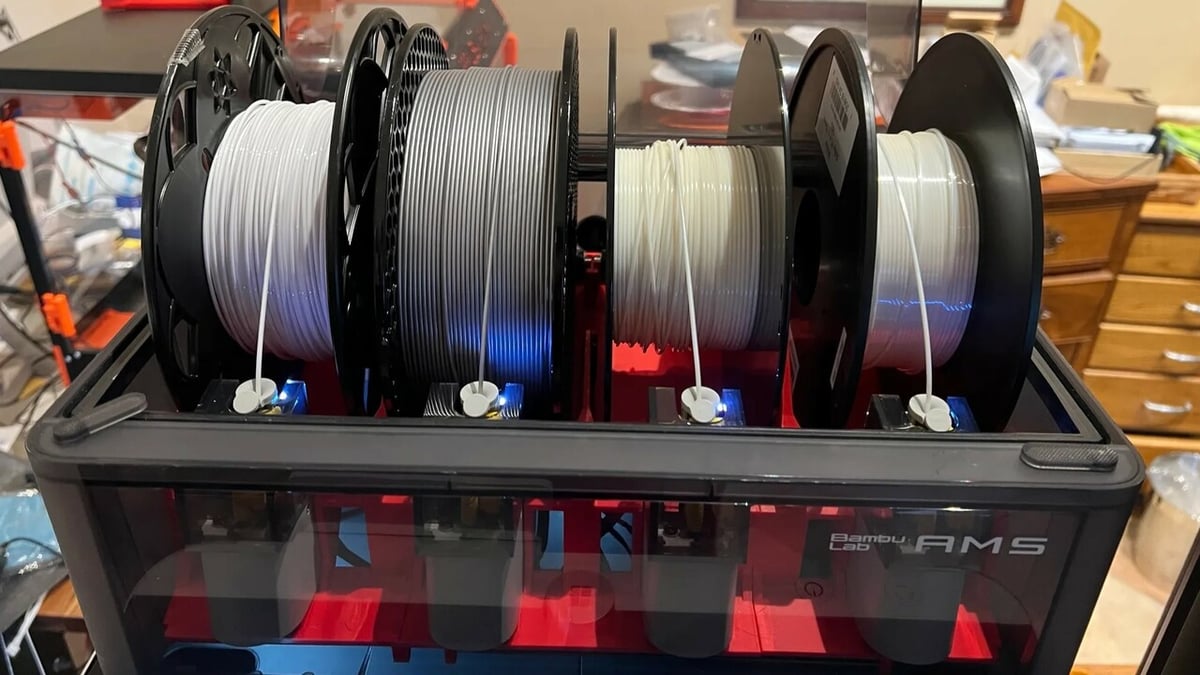
As with everything in the 3D printing community, people will come up with hacks and modifications to improve or change the features of a system, and the AMS is no exception.
One of the most popular modifications for the AMS is the Hydra spool adapter designed by Printables’ maker humebeam. This spool adapter allows the location of the rear roller to be altered while also having wider spool slots. These changes mean that more spools can be compatible with the AMS, no longer needing a specific spool size to work, so that users can print with almost any roll of compatible material. While makers can print this modification themselves, it can also be bought as a finished print from MatterHackers.
Another simple yet still very useful modification is the dryer pod inserts designed by STprinting. Users can print these pods and fill them with moisture-absorbing desiccant, then place them in between the spools in the AMS. This simple modification ensures that there’s no moisture in the AMS, creating a better environment for materials that are damaged by absorbing moisture.
Another simple modification to expand the spool compatibility of the AMS is the cardboard spool ring from maker Blizzard. These bumper rings can be printed out and snapped onto the outside of cardboard spools, reducing their friction and the dust they usually create, allowing them to be used with the AMS system.
Some other popular modifications to check out include this stacking system, which lets you stack multiple AMS units on top of each other, and this filament guide, which mounts to the top of the feeder unit with double-sided tape.
Additional Pros & Cons
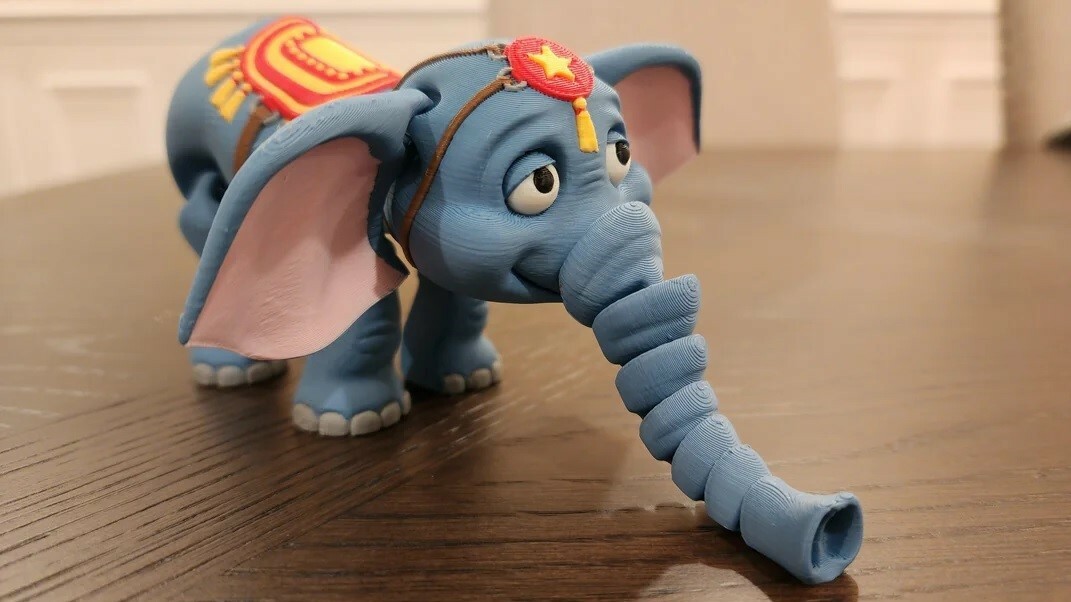
The AMS is a very capable system, perfect for multicolor and multi-material printing needs. Let’s look at some of the additional pros and cons that have not been touched on yet.
Pros
One special feature of the AMS system is that it gives users the option to link up to four AMS units together to feed into a single printer. This means that one print can have up to 16 different colors or materials. This type of performance in terms of coloration is unheard of in the 3D printing world for its price range. Keep in mind that you’ll need a total of four AMS units, a Bambu printer, and an additional AMS hub that connects the filament outputs of the four units, controlling which one gets sent to the hot end at what point.
Another advantage of the AMS system is that the spool holder is completely airtight. Being airtight allows users to store and use sensitive filaments that are very susceptible to absorbing moisture.
Cons
One downside of the AMS system is that the multicolor printing capabilities with a single nozzle mean that the machine produces a high amount of material waste. This waste is generally created with a purge block, which is an additional block printed to ensure that color changes are complete and that none of the colors bleed together. Bambu printers and many others on the market counter this waste by purging their color changes during the infill or supports, but a high amount of waste is still unavoidable.
Another disadvantage of the AMS is the fact that it’s closed-source. This means that any in-depth modifications that the community would usually create will be unavailable due to the public not being able to access the code and design files for the printer and AMS.
Additionally, a user will be held into the Bambu Lab product line because, for example, their own filaments work best with the AMS, meaning you’ll mostly have to buy from them. This same thing also applies to parts and repairs, making the actual printer and AMS unit difficult to modify or repair without sending the unit back to Bambu Lab.
How About the AMS Lite?
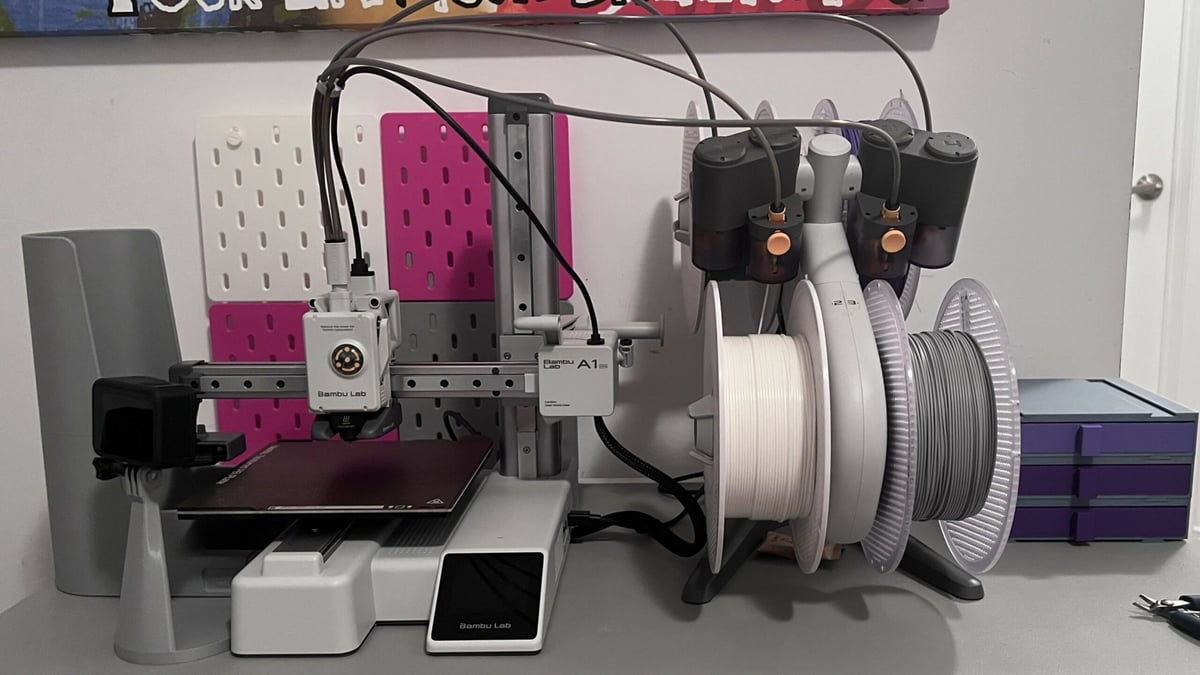
Bambu Lab also offers a compact variant of the AMS, known as the AMS Lite. Released in 2023, the AMS Lite is a freestanding four-filament-feeding add-on designed to be paired with the A1 series of printers. It offers similar multi-material capabilities as its larger, more expensive sibling, just in a smaller size.
There are a few differences to keep in mind about the two versions. While the standard AMS is expandable to 16 colors, the AMS Lite only goes up to 4. Additionally, as mentioned, the AMS is a sealed, airtight system, so you can prevent damage to moisture-sensitive filaments, while the AMS Lite is an open system. Since the standard AMS is rather heavy, it’s more stable and won’t move around your table or workspace. In comparison, the AMS Lite is pretty shaky if you’re printing at faster speeds. However, on the plus side, some makers have found that the Lite version is easier to maintain, compatible with more filaments, and facilitates faster filament changes than the standard AMS.
While there are not as many modifications available for the AMS Lite, there are still some nice options available. For example, this top mount bracket lets you mount the AMS Lite on top of your A1 printer. You can check out this YouTube video from Bambu Lab for helpful assembly instructions.
Alternatives
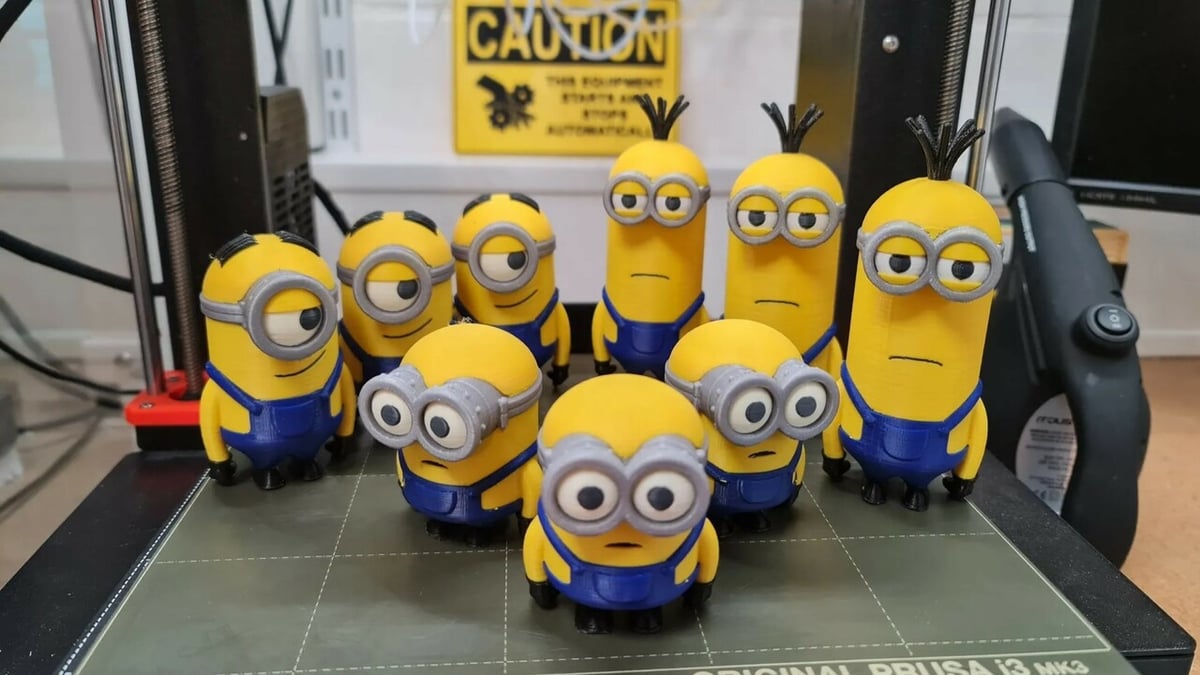
After this in-depth look at the AMS, let’s look at some other market alternatives that achieve the same outcome, although each comes with its own advantages and disadvantages.
The first alternative is Prusa’s well-known Multi Material Unit, or MMU. This device is much more compact than the AMS, while still mounting directly on top of the printer. Due to Prusa’s open-source approach, the MMU can be used on any printer running on Marlin firmware with a few modifications. However, this versatility means that the overall system isn’t as refined as the AMS, with users citing difficulties getting prints to work smoothly. Additionally, the MMU only takes in filament and doesn’t have a spool holder function like the AMS. In terms of material compatibility, the MMU should be able to handle any material, although it may need a little bit of adjusting in the settings to get flexible filaments to run smoothly.
Another alternative is the Palette 3 Pro from Mosaic. This system is very similar to the AMS, as it individually feeds eight different filaments and splices them together, creating one smooth multicolor strand according to its software. Because the Palette sits outside of a printer, the system can be used with any filament, including flexibles, and with any 3D printer, making it incredibly versatile. Similarly to the MMU, however, this system doesn’t include spool holders, so users will have to mount the eight rolls separately.
Last but not least is the Prusa XL – although note that this isn’t just an accessory that enables multicolor printing, it’s a 3D printer with multicolor and multi-material printing being just one feature. This printer has up to five separate hot ends, meaning that five-material prints are easy and consistent to achieve. Additionally, because of the independent hot ends, the XL can print with any material, easily being able to handle brittle and flexible filaments alike. As the multiple hot end system is integrated into the printer, users will have to spend upwards of $3,500 to get it. Since the printer has only recently been shipped to the public, user reviews are, at the time of writing, not abundantly available.
License: The text of "Bambu Lab AMS: How Does It Work Exactly?" by All3DP is licensed under a Creative Commons Attribution 4.0 International License.
CERTAIN CONTENT THAT APPEARS ON THIS SITE COMES FROM AMAZON. THIS CONTENT IS PROVIDED ‘AS IS’ AND IS SUBJECT TO CHANGE OR REMOVAL AT ANY TIME.
